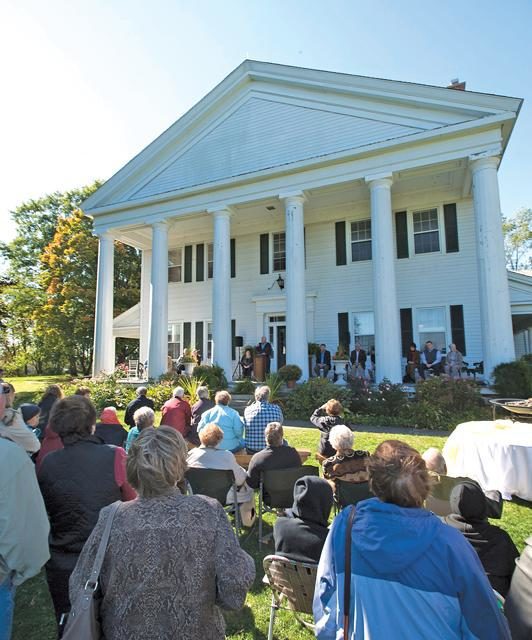“Gordon Hall is a house we all love. Many, many generous donors are helping to restore it properly,” says Bev Hill, president of the Dexter Area Historical Society, as she shares blueprints of the interior renovations planned for the stately home of judge Samuel Dexter on Island Lake Rd. “The outside is done for now. We’re excited to move our efforts indoors.”
Purchased from the University of Michigan for $1.5 million in 2004, Gordon Hall was built as the home of Dexter’s founder and namesake, Samuel William Dexter (although he always maintained he named the village for his father, who shared all three of his names). After ambitious fundraising efforts paid off its loan in 2014, grants and matching funds provided the $125,000 necessary to begin work with HopkinsBurns Design Studio of Webster Township. A recent fundraiser brought in nearly $50,000, enabling the society to launch Phase I of the hall’s long-anticipated interior renovations.
One of the oldest surviving properties in Dexter, Gordon Hall was built between 1841 and 1843 on a prominent knoll overlooking the Huron River and the village. Designed by local resident Calvin Fillmore, brother of future president Millard Fillmore, it is considered one of the finest examples of Greek Revival architecture in the Midwest and played host to two (or possibly three) U.S. presidents.
The home is also believed to have hosted escaped slaves fleeing to Canada–according to a county historic district report, and there is substantial evidence that Gordon Hall was used as a stop, or ‘station,’ on the Underground Railroad.
Dexter’s father was a U.S. senator who served as secretary of war under John Adams and secretary of the treasury under Adams and Thomas Jefferson. The younger Samuel, a Harvard graduate and abolitionist, earned his law degree in 1815 then left Boston for New York State in search of adventure. But after his first wife and son died, he decided to push farther west.
Dexter arrived in Michigan in the 1820s with $80,000 in his pockets. In addition to Dexter, he is credited with founding Saginaw, Ionia, and the village of Byron (which he named for the poet).
Maternal and infant mortality was still rampant then, and his second wife and son also died in 1827. The following year, Dexter married sixteen-year-old Millisent Bond. He platted the village in 1830, the same year Millisent gave birth to the first of their nine children, all but one of whom survived into adulthood.
The couple’s home doubled as the village’s first post office and church. Dexter donated land for the railroad, a Baptist church, and what is now Forest Lawn Cemetery, and served as the first chief justice of the Washtenaw County Court and as one of the first regents of the University of Michigan.
The judge died at the age of seventy-one, in 1863. A decade later, his widow attached a massive four-story Victorian tower to the rear of their home. She sold off all but seventy acres of the property before her death in 1899.
“Reconstructing this tower is not part of our plans. Gordon Hall will be restored to the way it looked during Judge Dexter’s lifetime,” Hill says.
After Mrs. Dexter’s death, the house passed through many hands, eventually becoming a boarding house. “It’s a miracle the property wasn’t subdivided for housing developments,” Hill says.
Gordon Hall was derelict and abandoned when Katharine Dexter McCormick, one of the judge’s last surviving descendants, bought it in 1938.
McCormick was only the second woman to graduate from the Massachusetts Institute of Technology and the first to earn a degree in biology. Throughout her lifetime, she conducted research in biochemistry and schizophrenia–her husband, Stanley McCormick, son of the mechanical reaper inventor, was institutionalized for most of his life with the disorder. She was instrumental in lobbying for the Nineteenth Amendment, cofounded the League of Women Voters, and almost single-handedly funded development of the birth control pill.
McCormick hired a U-M professor of architecture to help her restore Gordon Hall, demolishing the tower and returning the home to its original configuration. However, before the restoration was finished, she donated Gordon Hall and its remaining acres to U-M in 1950, with the understanding that the estate would be preserved as a landmark. The university immediately divided Gordon Hall into apartments for university faculty, gutting all the historic interior details and fixtures.
When the U-M decided to sell it, Dexter’s historical society leaped into action. Everyone from schoolchildren to natives, newcomers, and businesspeople contributed time, efforts, and funds. And the United Methodist Retirement Community, bought several acres to build a retirement community next door. After the society paid off its mortgage in 2014, it began work on restoring Gordon Hall’s exterior and grounds.
In mid-February, the society contracted with A. R. Brouwer for Phase I of the interior work: installing three bathrooms (two of them handicapped-accessible) on the first floor and an office/sitting room above them on the second floor. As soon as the weather looks promising, carpenters will demolish the cement back porch and build an exact replica of its 1843 predecessor.
Meanwhile, society members are feverishly raising money and writing grants for Phase II. By 2024, the historical society hopes to begin mechanical upgrades; install a small elevator; rip out all twentieth-century changes; create historically accurate millwork, ceilings, and doors, and hang historic fixtures. “Unfortunately, the university destroyed or carted away all the original woodwork, trim, and mantels, so we have to start from scratch,” Hill says.
“Once again Gordon Hall will be gutted,” says Jessica Quijano, a preservation architect with HopkinsBurns. “But this time we’ll return the interior to the way it looked in Judge Dexter’s day.”
